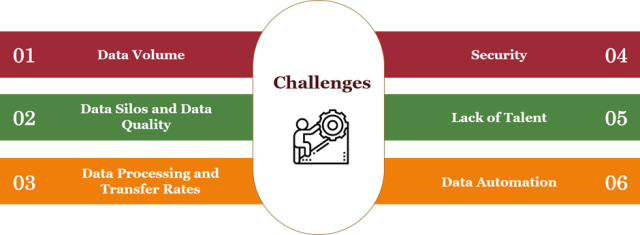The last decade or so has seen a big leap in technological advancements. One of the technologies to come up at this time and see a rapid elevation is Big Data. The basis of Big Data is that it helps improve operations, create personalized marketing campaigns, and provide better customer service. Big data is, well, big. It increases efficiency and leads to better revenue. Big Data is part of the data revolution we are currently living in. The rate at which data is being created is accelerating at an exponential rate. I was recently reading that there are currently more than 44 zettabytes of data in the entire digital space, with reported growth every year as per a research report published by PWC. Big Data requires a flexible and scalable infrastructure to work to the best of its capacity.
Big Data possesses tremendous opportunity for businesses, and they need to take advantage of it. With integration of Big Data, they will get real-time analysis and reporting while providing efficient storage and processing of the massive amount of data. There are several advantages to using Big Data, however, it does not come without its set of challenges. It is best to understand the challenges attached to technology for better management before diving in. The main challenges that businesses face related to Big Data Storage are security, data transfer rate, data volume and processing. Let us take a deeper look at these challenges in big data storage
Understanding the Challenges in Big Data
Big data incorporates unique set of challenges from data management to analysis and storage. These challenges require innovative and appropriate solutions to realize a successful big data storage and management. This can be achieved by employing best practices for big data, appreciating latest trends, and understanding the key big data elements.
Big data holds massive amounts of structured, unstructured, and semi-structured data produced from different sources. The key attributes of big data known as the leading Vs of big data highlights specific challenges and opportunities in handling big data in an enterprise.
Enterprises need to ensure proper data storage prior to data processing. The ideal place to store data is a data lake, which is a scalable unstructured database. Big data storage incorporates various technologies, such as distributed file systems, NoSQL databases, and cloud-based storage platforms. These storage solutions are designed to address and manage the massive scale and rapid growth attribute of big data environs. Enterprises must ensure the security of data stored on-premises, minimizing the cyber-attacks and threat of data breaches. As the size of the data generated cannot be predicted, it is necessary to support scalability in data storage solutions. It is important to choose optimal storage solutions to support a flexible and scalable data storage and analysis. The key challenges that exist in big data which will lead to challenges in proper data storage and management are shown in the figure below.

Data Volume
The quantity of data has grown swiftly in the last few years. And it is projected by experts to keep growing in the coming years. Large volumes of data can exceed the capacity threshold of the existing storage systems. These systems have not developed the capacity to work with the volume of data it is receiving. Unable to deal with the data volume is leading to storage sprawl with storage silos, multiple points of management, and consumption of a large amount of floor space, power, and cooling. Simply storing and sorting through the data becomes a huge task with an impact on productivity.
Most of the data that is collected is unstructured. This further adds to woes as it is tougher to sort out the relevant data. The systems need to have a scope for scalability in their infrastructure to accommodate and work with the incoming data. Dealing with these issues, businesses have started adopting object-based storage systems to easily scale large volumes of data objects within a single managed system. These systems, with their robust metadata, enable easier content management and tracking. It also uses dense, low-cost disk drives to optimize the physical storage space.
Data Silos and Data Quality
Data silos has become a significant challenge because of the scattered data from multiple sources. It becomes difficult to consolidate these data in a single source for analysis, making the decision-making process intricate for the enterprise. Because of the multiple data sources, enterprises will create redundancy in storage hardware, increasing the expense. Due to the scattered multiple data sources, the other key challenge which affect accurate decision-making process is the data quality. It is necessary to provide meaningful insights from the data sources to keep up the reliability and trust in data –driven decision-making.
Data Processing and Transfer Rates
With the explosion of Big Data, the cloud providers are finding ways to manage the extra storage and processing needs. Performance needs are also rapidly increasing, adding to struggles. The traditional hard disk drives are proving to be inadequate for the current as well as future needs. For most of the businesses, fast access to data is a requirement today. There is a need for real-time and quick analysis, which needs to be up to the mark for the digital systems.
One of the key issues with Big Data processing is its lack of speed. There are alternate methods like batch processing, but these methods take time too. It affects the analytics and the analytical functioning of a business. It is necessary to address the growing need for higher and faster performance; many cloud providers are turning to flash storage. In comparison with Hard Disk Drive (HDD), flash storage wins on performance. While there is the drawback of higher costs, the costs have been declining consistently. Experts are predicting that the cost of flash storage will be compared with Hard Disk Drive (HDD) soon.
In this fast-growing business environment, data gathered from multiple sources need to be stored and processed quickly. The sheer amount of data that is being collected and processed is incredible. The pace by which the data transfer happens helps with quick and real-time analysis. Better speed will directly influence the growth in new revenue streams. The volume of data has created a new problem; it affects the data transfer rate. Traditional methods are now struggling to cope. It is affecting the speed at which the data moves, slowing down the transfer rate which has a direct effect on the results.
Any delay in moving data into or out of storage is not acceptable. It adds to concerns. The lack of speed causes issues in the smooth functioning of digital systems. The use of public cloud for data storage has been seriously hampering data transfer rates. Businesses have started using private High-Performance Computing (HPC). The IT (Information Technology) systems now need to be designed to accommodate this ever-changing landscape, along with the traditional requirements of high availability, reliability, and backup.
Security
With the upswing of technology and all its advantages, several risks have also increased. There is a significant rise in data security concerns. All organizations are under the threat of cyber-attacks every day. It has become an extremely grave concern. Data is being stolen all over the world daily, making security a severe issue that needs to be tackled urgently. Thus, data security and sensitivity have become even bigger issues than before. To protect the high value and sensitive data from intrusion, theft, cyber-attacks, or corruption, a data scientist needs to take extra care.
There are many factors to consider related to security, privacy, and regulatory compliance. This has prompted many businesses to move away from public cloud environments and choose to store their data on a private cloud or a protected infrastructure. Even though, big Data has a layer of security, there is a risk of data theft. The chance of the data being compromised is always looming. Apart from protecting the environment, businesses could consider using techniques such as attribute-based encryption, and data masking and apply access controls to further protect their sensitive data.
Harnessing Talent for Big Data Success
Effectively utilizing the massive scale of big data opens substantial opportunities for enterprises, requiring specialized skill sets and expertise. Professionals experienced in Machine Learning (ML), Artificial Intelligence (AI), and advanced data technologies are at the forefront of this transformation. Enterprises are progressively investing in developing and attracting such talent to efficiently manage and analyze complex data sets, ensuring they take advantage on the benefits and opportunities that big data presents in the competitive market.
Data Automation
Data automation helps in streamline the data related operations to derive valuable insights from data for decision-making. However, due to the massive volume of big data and challenges in the availability of scalable infrastructure and technologies, data automation implementation stays as a key challenge.
These challenges pose issues for businesses, but it is not impossible to find solutions. Technology is always evolving and getting better, so there are ways these problems could be solved. Organizations can use techniques like compression or deduplication to adjust to remove the data that might not be relevant. Enhancing data security is probable with data encryption, identity and access control, and data segregation, for example. There is a lack of experience and expertise in big data storage in several cases which makes things tougher. These are some possible solutions to the storage challenges posed by big data.
In Conclusion
Data storage is becoming essential for various businesses. The data that is gathered is at the center of several functions in an organization. It helps improve the overall user experience. Big data has shown to be a successful solution in this situation because requirements are always on the rise. Big data can manage enormous volumes of data due to its unique structure. It may provide expansion and adaptability with both structured and unstructured data.
Big Data has a lot of scope in the coming years. Like every technology, it has its advantages and disadvantages to go with it. The potential is undebatable, but some issues need to be taken into consideration by businesses. Any technology is continuously evolving to adjust to new arising problems. They need a digital structure with better capacity, scalability, and flexibility. Storage solutions need to be handled by a skilled and experienced team of experts. Of course, there is no one solution that fits all. It is important to look at each business problem individually and define the customized storage approach.
Calsoft being a leading technology-first partner, providing digital and product engineering services incorporate wide range of software defined storage solutions to support growing data needs.






